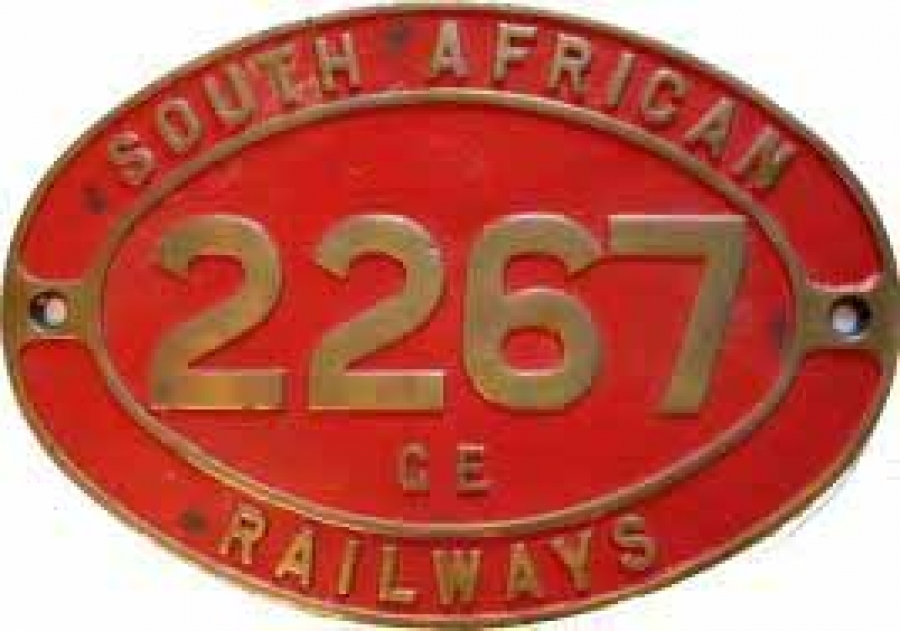- text and images per Paul Curtis.
Between 1909 and 1938 the South African Railways publicity department was responsible for most of South Africa’s internal and international tourism advertising – commissioning and publishing books, booklets and brochures on South Africa as the place to visit for the scenery, game viewing, healthy climate, golf, holiday resorts and … fishing. Most of which could be accessed from the comfort of a luxuriously appointed railway carriage or one of the fine hotels that were built adjacent to the local railway station. Much of this promotional material was aimed at well-heeled British tourists and carried additional advertising for hotels such as Cape Town’s famed Mount Nelson and the Nottingham Road Hotel near the Mooi River in Natal. There were also advertisements for fishing tackle dealers, outfitters, clothing, and boot retailers – one early one in 1909 by a tackle dealer in Pietermaritzburg who styled himself as John Hardy & Sons, ‘Importers of High-class Fishing Tackle’. When I checked with Hardy Bros. U.K. a few years back if they indeed had a branch or associate in ’Maritzburg at the time, they said definitely not. An early case of identity theft?
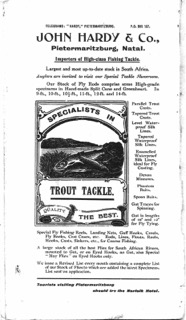
Early Natal Tackle Advertisement
That there was publicity about South African fishing in those days is not surprising – the fishing in the early 1900s was extraordinary. Trout had been recently introduced and were thriving. And more and more indigenous freshwater and saltwater fishing was easily accessible thanks to the rapidly expanding South African road and rail network after South Africa became a Union in 1910. That there was so much written and published about fishing is, however, a little surprising – until you do some background research into the man responsible for most of the S.A.R.’s publicity, General Manager W.W. (Sir William) Hoy.
Sir William Hoy
S.J. du Toit, South African historian, writes in Hermanus Stories that Hoy was a farmer’s son, born in a croft at Arnot Mill in Kinross-shire, Scotland. His early life was extremely frugal and at the age of twelve he left school to seek his fortune in Edinburgh. He found it with the North British Railways as a clerk earning the princely sum of twelve shillings a week. He learnt Pitman’s shorthand as part of his training and became so skilled that he earned extra money teaching it at night school. In 1890, a recruiting officer from the Cape Government Railways arrived in Edinburgh and Hoy, then in his early twenties, applied for a post and was accepted. While working for the Railways in Cape Town he entered a shorthand writing competition for public servants and won easily, becoming known as Hoy – the fastest writer in South Africa.
With a sobriquet like that, how could he fail! After two years in the country he became chief clerk in Kroonstad, and shortly after that the Transvaal agent for the Railways. During the Anglo-Boer War (1899–1902) he had complete charge of all British military railways in South Africa aged just twenty-eight. In 1910 he became the youngest ever General Manager of the Railways and was knighted in 1916 for services to his adopted country.
By the time ill-health forced him to take early retirement in 1927, he had also set up the Rhodesian Railways and the S. A. R. road transport division, as well as his ubiquitous publicity department. Hoy was something of an autocrat and so dominated the South African transport industry that South African Railways was apparently often referred to more simply as W. W. Hoy Limited.
In his spare time Hoy fished. He commanded his train drivers to carry tanks of trout fingerlings from the Jonkershoek hatchery in the Cape Province, the length and breadth of South Africa, releasing them wherever they judged suitable water to be. He was a renowned saltwater fisherman with several records to his name, and doubtless cast a line at the end of every track his trains went to. However these trains never arrived at the best fishing destination of all – Hermanus in the Cape which, at the time, was South Africa’s premier saltwater fishing resort. This despite the fact that plans to bring the railway to Hermanus were at a stage so advanced that the town fathers had built a fancy new railway station ready to welcome the first passengers. The stumbling block was Hoy himself – he had his holiday home in the town overlooking his personal favourite fishing spot and wasn’t keen to share it with the hoi polloi arriving en masse to bother ‘his’ fish, so he refused to sign off on the tracks coming through! Hoy died in 1930 and is buried with his wife on the koppie that bears his name, overlooking famous-for-whale-watching Walker Bay at Hermanus.
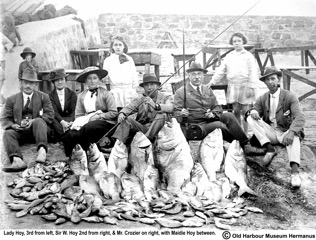
W.W Hoy fishing party
TROUT FISHING IN NATAL
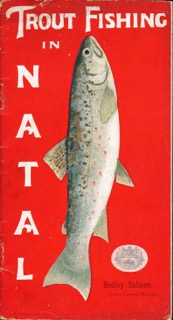
Trout Fishing in Natal 1919
The first fishing publication that South African Railways brought out was Trout Fishing in Natal, a 27-page booklet published in December, 1909. A copy of this caused something of a sensation in South African fishing book collector circles in 2015 when it fetched $1 800.00 at auction online. Which is not surprising as it’s the rarest of the rare. I’d only ever heard of five copies in existence – three in public library archives and two in private hands, and both privately-owned books had gone ‘walkabout’.
I admire the first line of the booklet: ‘It is a shallow as well as a dismal scheme of life which ignores or undervalues the importance of recreation.’ The twenty-seven pages that follow are illustrated with 25 black and white photographs and cover the rivers to fish for trout in Natal, the fishing season and licence required, helpful fishing hints and recommended flies and, naturally, being put out by a railway company, timetables of how to get to Nottingham Road station and the fishing. This timetable seems somewhat strange – while it supposedly took just 9 hours and 51 minutes to get to Nottingham Road by train from Pretoria, it took 8 hours and 27 minutes from Harrismith (which is more than half way there). The trip, though, from Potchefstroom took 31 hours 30 minutes, and from Bloemfontein, a back-breaking 46 hours! You’d have to stay a month just to recover.
Besides the previously mentioned advertisement for the pseudo Hardy tackle merchant in Pietermartzburg there are two others, one for H. Singleton’s Nottingham Road Hotel and a second with the headline ‘An Angler’s Paradise’ for a ‘new’ bungalow on the Mooi – ever after known simply as Trout Bungalow. A month’s accommodation at the hotel (with free fishing of the lower Bungalow waters) would set you back £9 10s, and a week at the Bungalow £4 10s – ‘with over 60 miles of water (both banks) on the Mooi and Little Mooi Rivers. The photographs in the booklet include shots of the various rivers, the mule cart to get you to the Bungalow, the Bungalow itself, Nottingham Road Hotel, heroic catches of fish, Bushman paintings and a card of the trout flies kept in stock at the Bungalow.
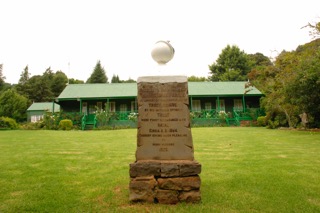
Trout Bungalow today
Of interest too, is that this booklet is not the first time Mr. Singleton’s Nottingham Road Hotel or the waters he had for guests is mentioned. An earlier report was by newspaper magnate Cecil Harmsworth M.P. (later Lord Harmsworth) in his book Pleasure and Problem in South Africa (1908). A chapter in the book ‘On the Mooi River in Natal’ describes that after arriving by train, his party set off in two vehicles for the fishing 18 miles away: ‘The two ladies and the captain driven by Mr. Singleton in his 4-wheeled dog-cart’ while Harmsworth went by Cape cart. He describes the beauty of the scenery and then the heat and dust, writing: ‘Of the last two miles I can only say that to travel them in a Cape cart is a day’s exercise for any man’. He had a few days fishing at the McQueen’s farm, and then ‘fearful of the eighteen mile drive back to Nottingham Road’ spent an extra day or two fishing on another farm belonging to a Mr. Dickens. His fishing did not appear to be too successful, Harmsworth, in turn, blaming the weather (hot and dry), the water, (too clear and low), his choice of flies (too big) and finally, his lack of skill.
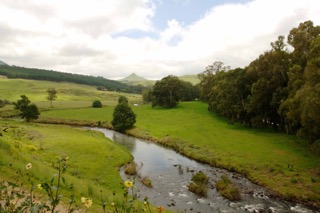
The Mooi below the Bungalow
Another well-known Englishman, Sir George Aston (George Southcote), wrote about the Mooi in even earlier days. In a chapter ‘A Natal Trout’ in his book Mostly about Trout (1921) he too describes the rigours of a long drive in a Cape cart from Nottingham Road to the Inchbrakie Falls (now submerged under the new Spring Grove Dam). Why I think he was even earlier than Harmsworth is that he writes there was no accommodation to be found on the banks of the Mooi whatsoever and camping was essential. He was, however, more successful a fisherman and caught several trout, including a three-and-a-half pounder that fought ‘like a sulky salmon’. In the same book Aston has a chapter ‘Sea-fishing in Simon’s Bay’ where he had some exciting ‘snook’ fishing and also managed to lose the tip of his thumb when he stuck it in a small elf’s mouth to unhook it. Like many fishermen before and since, he learnt about the razor-sharpness of elf’s teeth the hard way.
Trout Fishing in Natal is, as I’ve mentioned, extremely rare. Fortunately though, the entire booklet has been included (virtually unchanged in text, with a few different pictures) as a chapter in the large general handbook, Natal Province (1911) – which is not that scarce. Natal Province, which was also sponsored by the S.A.R., covers all aspects of life and industry in Natal in 1911 and is a fascinating read in its own right.
TROUT FISHING IN SOUTH AFRICA
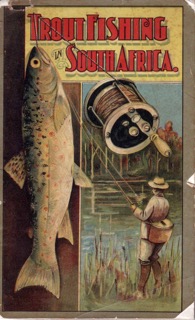
Trout Fishing in South Africa 1913

Trout Fishing in South Africa 1916
The next two fishing books the Railways brought out were a lot more substantial and covered the whole country, but again focused solely on trout fishing. They were the ‘Official Guide’ Trout Fishing in South Africa (1913) and a slightly expanded and updated book with the same title in 1916
Both are paperbacks with extremely attractive covers. The 1913 edition has 118 pages and the 1916 has 124. There are forty-six and fifty-eight pages respectively of photographs or photographic montages showing large bags of fish (no catch and release in those days), fishermen and fishing scenes countrywide plus four maps of the Western Cape, Eastern Cape, Natal and Transvaal fishing areas.
The advertisements are interesting – mostly for hotels near good fishing – including the Nottingham Road, Dargle and Rosetta hotels and the Trout Bungalow in Natal, the Ceres Hotel in the Western Cape, the Waterval Boven Hotel and the Transvaal Arms (then headquarters of the Rand Piscatorial Society), plus a host of now out-of-business tackle dealers. The 1916 edition though has a genuine and marvellously snooty ad from the real Hardy Bros. Ltd., of Alnwick and Pall Mall England.
In true British Empire style on addressing colonials, it begins: ‘To South African Anglers and dealers who do not seem to have developed that taste for fine quality in their rods reels etc.,’ and goes on to suggest that every real angler in Europe, America, New Zealand, Australia and India knows that it’s just not done to catch any fish on anything other than Hardy tackle.
The introduction to this edition of Trout Fishing in South Africa is somewhat flowery: ‘At last, after years of work and expense, trout fishing, perfect in every respect, is to be had in our land within easy distance of all; the incredulous hope of many a year is realised, and the South African angler has now reached the highest pinnacle of bliss.’ It goes on to describe the best fishing in each province, whom to apply to for permission to fish and local provincial rules and regulations and maps.
There’s also a useful chart identifying the town closest to the fishing, nearby hotels, costs and, naturally, railway timetables and the nearest railway station to both hotel and stream.

The usual big bag of fish
Hotel prices certainly make interesting reading: if you wanted to fish the Eerste River, the Masonic in Stellenbosch would set you back 8/6d a night, fish the Berg or the Dwars and stay at the Royal in Paarl for 7/6d. The Central in Maclear was 8/6d and the famous Trout Bungalow on the Mooi would cost you 12/6d.
If you wanted to climb Table Mountain (no cable car in those days) and fish the reservoirs on top – apparently many anglers did – the Mount Nelson would set you back fifteen bob a night. I googled the Nellie prices online to check what a suite would cost me during the Christmas break, just in case I decided to give those reservoirs a whirl and the price quoted was around ₤1 000 per night single, breakfast included (but not a helicopter). As my dad used to say, a bargain – if they were serving humming bird tongues. There were apparently thousands of copies of these elaborate guide books distributed in South Africa and the UK to promote travel on the Railways but very few survive today.
SALT WATER ANGLING IN SOUTH AFRICA
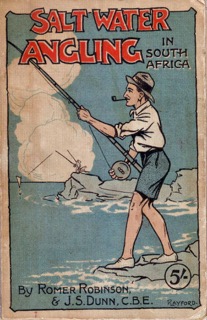
SaltWater Angling in South Africa 1923
The next book the South African Railways were involved in was the first general South African salt water angling book, Salt Water Angling in South Africa by Romer Robinson and J.S. Dunne – although the Railways did not actually publish it. The book was originally commissioned to be a companion ‘brochure’ to go with Trout Fishing in South Africa. However when the work on the book was almost complete and the Railways Publicity Department was about to publish it they were stopped by the Union Government which had put a halt ‘indefinitely’ on governmental publications because of the ‘depression and financial difficulties’ of 1921.
The Railways Publicity Department then handed over the letterpress and photographs to co-author Romer Robinson ‘for production on his own initiative’. He a member of the Robinson family who founded the Natal Mercury newspaper and allied Robinson & Co. printing works and so decided to ‘self-publish’.
Salt Water Angling in South Africa eventually came out in 1923 and is a considerable book of 315 pages. There are numerous black and white photographs, mainly the usual large dead fish or large bags of fish with anglers posing next to them in their Sunday finery. There are also photographic montages that double as advertisements promoting the main fishing resorts along the Cape and Natal coastlines.
There are fourteen chapters on Natal sea fishing, eleven chapters on the Cape, a chapter on Selkirk the famous Hermanus shark fisher, and recommendations on the tackle and tactics to use in pursuit of various fish species. The book is well-written, well-edited, and stuffed with interesting anecdotes and information. If you can find a copy, buy it, it’s a great read even today. There will never be fishing as good again.
The only thing that lets the book down is the quaint illustration on the cover. A dapper, behatted gentleman, pipe in mouth, in shorts and a white shirt, ‘plimsolls’ on his feet, playing a fish while standing on a rock that’s, at most, six inches above the water. No surf in South Africa in those days it seems.
It is interesting that the 1921 ‘depression’ seemed over by 1923 as the Railways did indeed publish a general tourist book in that year South Africa Land of the Outdoor Life in which there were two chapters on sea fishing. This general book was written by the selfsame Robinson and Dunn who wrote Salt Water Angling in South Africa.
TROUT FISHING IN SOUTH AFRICA (REVISED)
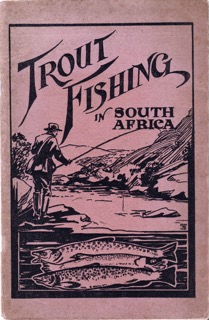
Trout Fishing in South Africa 1924
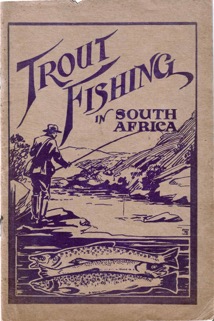
Trout Fishing in South Africa 1925
In 1924 and 1925 the S.A.R. revised their trout fishing literature, with two new shorter books – this time commissioning Sidney Hey (who was later to write South Africa’s finest fishing book Rapture of the River) to write them. The books were only 52 and 48 pages long with 39 pictures and covered similar ground – brief descriptions of the principal trout streams of the Cape and Natal with a brief excursion into the recently stocked Transvaal streams. The emphasis, however, of the best fishing had switched from Natal to the Eastern Cape highlands. Hey wrote of Maclear in the Eastern Cape as ‘the cream of South African fishing’ and eloquently describes the beauty of the area, the flora and fauna and the ease of catching fish on over ‘400 miles of well-stocked trout water’ in the district. This concentration on the Eastern Cape waters was not surprising as Hey was the Postmaster of Maclear and was much more familiar with those waters. The 1924 edition also has a chapter on the British Empire Exhibition of that year in London, for which Hey had been commissioned (by the South African Department of Mining and Industry) to prepare an exhibit on trout fishing in South Africa and to help make a film of the Eastern Cape and Natal fishing. This exhibition and film apparently went down very well and the exhibit was awarded a gold medal.
The 1925 book also had a short section on freshwater fish other than trout and a brief mention of fishing for tiger fish. Hey suggested though, ‘that any brave souls who wanted to fish the Transvaal for tiger, what with the fever and blood-thirsty crocodiles, should consult the well worth reading Bennion’s book, The Angler in South Africa’.
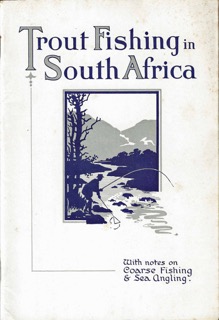
Trout Fishing in South Africa 1929
In 1929 the Railways completely revamped Trout Fishing in South Africa adding (With Notes on Coarse Fishing and Sea Angling) to the title. Sir William Hoy had retired in 1927 and the new management of the Railways, as is par for the course with new management (especially in the marketing area) decided to re-invent the wheel. Sidney Hey’s services were dispensed with and a new writer, who wrote as if he had not been long off a Union Castle boat from Southampton, produced what is more gushing travelogue than fishing book.
This guide is very definitely aimed at the British market. Snippets such as: ‘In South Africa … the land of the springbok and the Zulu … where the seasons are reverse to the northern hemisphere, and Christmas is spent in a silk suit rather than a fur coat’, sum it up. There is much information, however, about who to contact for fishing, which must have been useful for the overseas visitor.
There are 37 photographs, many of them new to the guide, including two of a rather luxurious dining car and a sleeper carriage. The cover is almost the best thing about the book though – a fine example of the Art Deco of the times.
Although this guide is primarily about trout fishing, there are nine pages on ‘coarse’ fishing covering tiger fish, yellowfish, barbel, freshwater mullet, carp, eel and freshwater bream. There are also two pages on sea angling with Hermanus and St. Lucia Bay featured. However this paucity on sea angling information was possibly deliberate as the Railways were shortly to bring out a much more comprehensive 32 page booklet, Sea-Angling in South Africa, which came out in 1930.
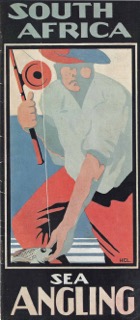
Sea-angling in South Africa1930
Topics covered in the new booklet include: ‘lagoon fishing; sea angling in Natal; Natal resorts; principal game-fish in Natal waters; vermin (mainly sharks & skates); a list of records; tackle for lagoons, surf rocks & piers; some useful baits; some hints for beginners; mounting rods; time and tide; angling in Cape water; chief sporting species in Cape waters and some angling resorts in Cape waters’. There is specific mention of Hermanus and the ‘seemingly Herculean feat’, i.e. the capture by Bill Selkirk of a shark weighing 2,176lb and measuring 13 feet 3 inches.
The 1929 Trout Fishing and the 1930 Sea-Angling booklets were aimed at attracting overseas anglers to South Africa. Unfortunately for the Railways, these fine little guides came out as the Great Depression began, so were unlikely to have achieved their aim of luring hordes of silk-suited anglers to South Africa.
FISHING IN SOUTH AFRICA
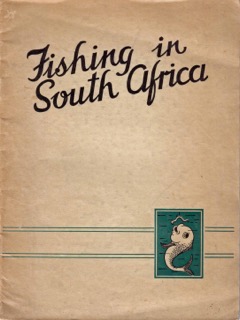
Fishing in South Africa 1938
The last fishing booklet brought out by the South African Railways (in 1938) was another on fishing in general. It covered saltwater, trout and ‘coarse’ fishing (a term which never caught on in South Africa) in all four provinces – albeit the section on the Free State is only four paragraphs long. It has quite detailed suggestions on where to fish and which species to expect – but the value is really in its photographs. Including a great shot of female trout angler, Miss Mary Chaplin (daughter of F.G. Chaplin, Curator of Jonkershoek), netting a fish on the Eerste River. There’s also a photo of Selkirk, the Hermanus shark catcher, titled: ‘A smallish shark caught at Hermanus’ (looks about a five hundred pounder to me). There are a few nice shots of Natal and Cape streams and one of a Transvaal stream. And, lastly, there’s a possibly historic shot of a 4lb yellowfish caught on a fly – the first ever such photograph?
What lets this booklet down though is the saddest cover ever on a S.A. Railways fishing brochure – just the title, a couple of stripes and a small cartoon fish rising to a dangling worm. Since this appears to be the last fishing booklet done under their auspices, it was a poor way to go out. The South African Railways and their fine fishing guides were, over the years, of great value to both local and overseas fishermen. Today these old guides offer a superb window into the magnificent fishing to be had in South Africa in the early 1900s. We owe a great debt to W.W. Hoy, the fishing mad railways boss of the time, and to his company, for this. They never did though bring the tracks to Hermanus … but the station remains, waiting patiently.
‘The Railway Company that Published Fishing Books’ is an edited excerpt from Paul Curtis’s new book Fishing Wider Margins. You can read all about Fishing Wider Margins(and a couple of other excerpts and reviews) at:www.platannapress.co.za
For more information please email Paul at: This email address is being protected from spambots. You need JavaScript enabled to view it.

